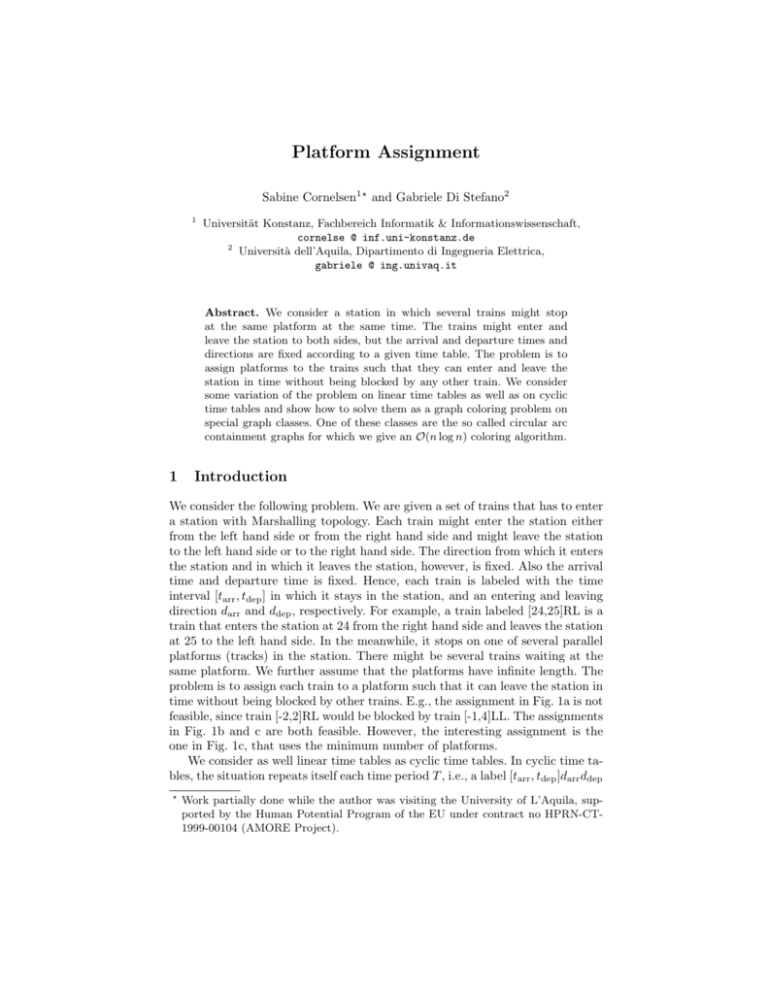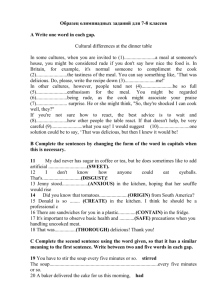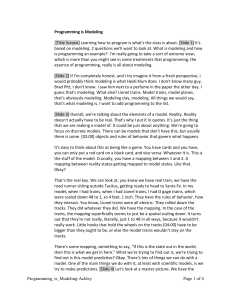Platform Assignment - Algorithmics
advertisement

Platform Assignment
Sabine Cornelsen1? and Gabriele Di Stefano2
1
Universität Konstanz, Fachbereich Informatik & Informationswissenschaft,
cornelse @ inf.uni-konstanz.de
2
Università dell’Aquila, Dipartimento di Ingegneria Elettrica,
gabriele @ ing.univaq.it
Abstract. We consider a station in which several trains might stop
at the same platform at the same time. The trains might enter and
leave the station to both sides, but the arrival and departure times and
directions are fixed according to a given time table. The problem is to
assign platforms to the trains such that they can enter and leave the
station in time without being blocked by any other train. We consider
some variation of the problem on linear time tables as well as on cyclic
time tables and show how to solve them as a graph coloring problem on
special graph classes. One of these classes are the so called circular arc
containment graphs for which we give an O(n log n) coloring algorithm.
1
Introduction
We consider the following problem. We are given a set of trains that has to enter
a station with Marshalling topology. Each train might enter the station either
from the left hand side or from the right hand side and might leave the station
to the left hand side or to the right hand side. The direction from which it enters
the station and in which it leaves the station, however, is fixed. Also the arrival
time and departure time is fixed. Hence, each train is labeled with the time
interval [tarr , tdep ] in which it stays in the station, and an entering and leaving
direction darr and ddep , respectively. For example, a train labeled [24,25]RL is a
train that enters the station at 24 from the right hand side and leaves the station
at 25 to the left hand side. In the meanwhile, it stops on one of several parallel
platforms (tracks) in the station. There might be several trains waiting at the
same platform. We further assume that the platforms have infinite length. The
problem is to assign each train to a platform such that it can leave the station in
time without being blocked by other trains. E.g., the assignment in Fig. 1a is not
feasible, since train [-2,2]RL would be blocked by train [-1,4]LL. The assignments
in Fig. 1b and c are both feasible. However, the interesting assignment is the
one in Fig. 1c, that uses the minimum number of platforms.
We consider as well linear time tables as cyclic time tables. In cyclic time tables, the situation repeats itself each time period T , i.e., a label [tarr , tdep ]darr ddep
?
Work partially done while the author was visiting the University of L’Aquila, supported by the Human Potential Program of the EU under contract no HPRN-CT1999-00104 (AMORE Project).
[−4,1]RL
[−3,3]RR
[−1,4]LL
[−2,2]RL
L
[−4,1]RL
R
a)
[−3,3]RR
L
R
b)
[−1,4]LL
[−4,1]RL
[−2,2]RL
[−1,4]LL
[−3,3]RR
L
[−2,2]RL
R
c)
Fig. 1. a) A non-feasible platform assignment. b) A feasible platform assignment that
is achieved with the first-fit algorithm. c) A feasible platform assignment that uses the
minimum number of platforms.
represents a series of trains (zi )i∈Z . Train zi arrives at time tarr + iT from direction darr and leaves at time tdep +iT in direction ddep . We further assume that no
train stays longer than the time period T in the station, i.e., that tdep − tarr < T .
The goal is a platform assignment that repeats itself every time period T , i.e.,
to assign each train of a series belonging to the same label to the same platform.
E.g., we are not interested in an assignment as indicated in Fig. 2a, but rather
in an assignment as indicated in Fig. 2b.
a)
[−8,3]RL [−5,5]RL [−3,9]RR
[−4,2]RL [−2,4]RL
[−4,2]RL [−2,4]RL
[−8,3]RL [−5,5]RL [−3,9]RR
[−5,5]RL [−3,9]RR
[−4,2]RL [−2,4]RL
b)
[−8,3]RL
Fig. 2. Cyclic platform assignment with time period T = 16. a) A platform assignment
that repeats itself every second time period. b) A cyclic platform assignment that
repeats itself every time period.
As an additional constraint, we will sometimes consider the so called midnight
constraint, i.e., the condition that all trains enter the station before the first
train leaves the station. The name of this constraint is motivated by shunting
problems in which all trains enter a shunting depot in the evening and leave
it in the morning. But the midnight constraint even seems to be a reasonable
constraint for modeling the situation in some stations where first all trains enter
the station such that passengers can change trains and afterwards all trains leave
the station. A train is a turning back train, if it leaves the station in the direction
from where it entered it, i.e., if darr = ddep .
The platform assignment problem is closely related to the shunting problem
some variation of which have been studied in the following work [1, 3, 5, 6, 8, 13].
We will consider the platform assignment problem as a graph coloring problem.
Given a platform assignment problem, we define the following constraint graph.
The vertices of the graph are the trains (or the series of trains if cyclic time
tables are considered). Two trains are adjacent if they cannot be put on the
same platform. The platform assignment problem then corresponds to coloring
the constraint graph. For some variation of the shunting problem, this approach
has been studied, e.g., in [4, 12].
In this paper, we show the following results for the platform assignment
problem. In the cases of linear time tables with midnight constraint or without
turning back trains, we show that the constraint graph is a permutation graph
and hence it can be colored in O(n log n) time. However, the algorithm does not
consider the trains in the order in which they enter the station. We further give
a 2-competitive online-algorithm to solve this problem. This algorithm also runs
in O(n log n) time.
In the case of cyclic time tables with midnight constraint, the constraint
graph is not necessarily perfect. For this problem, we give a 3-approximation
algorithm that runs in quadratic time. Cyclic time tables without turning back
trains yield a constraint graph that is a comparability graph and, hence, can be
colored in O(n2 ) time. If we further restrict the input to trains all entering from
the right hand side and leaving to the lefthand side the constraint graph is a
circular arc containment graph. We show how to color such graphs optimally in
O(n log n) time. The results are summarized in the following table.
with midnight constraint
without midnight constraint
without turning back trains
without midnight constraint
only type RL
linear time table
cyclic time table
O(n log n)
3-approx within O(n2 )
O(n2 )
O(n log n)
O(n log n)
The distribution of this paper is as follows. In Sect. 2, we give a formal definition of the platform assignment problem and show that it is equivalent to
coloring the conflict graph. In Sect. 3, we consider some variations of the linear
platform assignment problem and in Sect. 4 variations of the cyclic platform
assignment problem. As a byproduct, we give our algorithm for coloring circular
arc containment graphs in Sect. 4.2. Finally, in Sect. 5, we discuss some open
problems.
2
The Conflict Graph
In this section, we give a formal definition of the platform assignment problem
with linear or cyclic timetable, define the conflict graph and show that the platform assignment problem is equivalent to the coloring problem on the conflict
graph.
Linear Platform Assignment Problem (LPA) Given a set
(1)
(1)
(n)
(n)
(1)
(n)
(n)
Z = {[t(1)
arr , tdep ]darr ddep , . . . , [tarr , tdep ]darr ddep }
of train labels (tarr , tdep ∈ R, tarr < tdep ; darr , ddep ∈ {R, L}}) with the property
that all arrival and departure times are distinct and given a number k, is there an
assignment p : Z → {1, . . . , k} such that the following train operation procedure
does not return false?
(i)
(i)
(i)
(i)
(i)
(i)
1. Sort arrival and departure times increasingly.
2. For all arrival and departure events in the sorted list
(a) If the next event is an arriving train z. If z arrives from the right, append
z to the righthand side of list Lp(z) else append z to the lefthand side of
Lp(z) .
(b) If the next event is a departing train z. If z departs to the righthand side
and is on the righthand side of list Lp(z) , or if z departs to the lefthand
side and is on the lefthand side of list Lp(z) then delete z from Lp(z) , else
return false.
For a train label z = [tarr , tdep ]darr ddep , an integer i and a time period T set
z + iT = [tarr + iT, tdep + iT ]darr ddep .
Cyclic Platform Assignment Problem (CPA) Given a set Z of train
labels (with the property that all arrival and departure times are distinct), a
time period T (such that tdep − tarr < T for all [tarr , tdep ]darr ddep ∈ Z) , and a
number k, is there an assignment p : Z → {1, . . . , k} such that the above train
operation procedure applied to {z + iT ; z ∈ Z, i ∈ Z} (with p(z + iT ) = p(z))
would never return false?
The conflict graph for a platform assignment problem (Z, k) or (Z, T, k),
respectively, is defined as follows. The vertices are the train labels. Two vertices
z1 and z2 are adjacent if and only if the platform assignment problem ({z1 , z2 }, 1)
or ({z1 , z2 }, T, 1) is a false-instance.
Graph Coloring Problem Given a graph G = (V, E) and a number k. Is
there an assignment c : V → {1 . . . , k} such that c(v) 6= c(u) for {u, v} ∈ E?
Theorem 1. Let G be the conflict graph of a platform assignment problem (Z, k)
or (Z, T, k), respectively. Then the solutions of the platform assignment problem
and the solutions of the graph coloring problem correspond.
Proof. Let p : Z → {1, . . . , k} be a solution of the platform assignment problem.
Let p(z1 ) = p(z2 ). Assume without loss of generality that z1 has to leave the
station before z2 and that z1 departs to the right hand side. If {z1 , z2 } where
an edge of G then, by definition of the conflict graph, z2 would be on the right
hand side of z1 at the time that z1 had to depart. But then p would not have
been a valid assignment. Hence setting c(z) = p(z), z ∈ Z yields a solution for
the graph coloring problem.
Now, let c : Z → {1, . . . , k} be a solution of the graph coloring problem. Set
c(z) = p(z), z ∈ Z. Suppose that at some point the train operation procedure
returns false. So suppose without loss of generality that at some point z1 has
to leave to the right hand side, but that there is another train z2 in the list
Lp(i) on the right hand side of z1 . But then {z1 , z2 } would be an edge in G –
contradicting that c is a valid coloring.
t
u
A transitive orientation of an undirected graph G = (V, E) is an orientation
of its edges with the following property.
(u, v) ∈ E and (v, w) ∈ E =⇒ (u, w) ∈ E
A comparability graph is a graph that has a transitive orientation. A permutation
graph is a graph G that is associated with a permutation π of the set {1, . . . , n}.
The set of vertices of G is {1, . . . , n} and two vertices i and j with i < j are
adjacent if and only if π(i) > π(j). A graph G is a permutation graph if and
only if G and its complement are comparability graphs (see e.g. [7, p. 158]).
The chromatic number of a graph G is the minimum number k such that (G, k)
is a yes-instance of the graph coloring problem. A graph G is perfect if for
all induced subgraphs H of G the size of a maximum clique of H equals the
chromatic number of H. Comparability graphs and, hence, permutation graphs
are perfect [7, p. 133].
The first-fit algorithm is a heuristic to solve the graph coloring problem. It
works as follows. Start with an ordering v1 , . . . , vn on the vertices. Color the
vertices in this order. Assign vertex vi the first color that was not assigned to an
adjacent vertex of vi . Chvátal [2] characterized all orderings that are such that
the first-fit algorithm solves the graph coloring problem on the graph and all its
induced subgraphs optimally. This is for example true, if the vertices are ordered
according to a transitive orientation. In general, the first-fit algorithm runs in
O(n2 ) time. For permutation graphs, it can be implemented to run in O(n log n)
time (see e.g. [7, p. 168]). Note however that for arbitrary vertex-orderings the
first-fit algorithm can behave arbitrarily bad even on permutation graphs [10].
3
Linear Timetables
In this section, we consider three variations of the LPA. In Sect. 3.1, we assume
that the midnight constraint is given. Else even the restricted problem in which
every train enters from and leaves to the right hand side is N P-complete: it
corresponds to coloring circle graphs (see, e.g., [4] for a review). In Sect. 3.2,
we consider an online solution for the LPA with midnight constraint. Finally, in
Sect. 3.3, the midnight constraint need not be true, but there may not be any
turning back trains. In the following let n be the number of trains in an instance
of an LPA.
3.1
With Midnight Assumption
In this section, we assume that we are given an input of the LPA with the
midnight constraint, i.e., that the time intervals intersect in at least one point.
For example, in Fig. 1, 0 is a common point in all time intervals. Let Gmid
lin
be the conflict graph for this problem. A schematic image of Gmid
lin is indicated
in Fig. 3. Each rectangle represents all trains that have the same arrival and
departure direction. E.g., the rectangle labeled RL represents all trains with
darr = R and ddep = L. We will refer to this as the type of a train. Within one
↑
↑
and
indicate that there is an edge between two trains
rectangle,
↑
if the time intervals overlap, but neither is contained in the other.
and
↑
indicate that there is an edge between two trains if the time interval of
one train is contained in the time interval of the other train. The edges between
the rectangles indicate when there is an edge between two trains of different
type. An orientation of the edges is visualized by upward pointing arrows.
RR
LR
↑
O W.. ^==
. =
LL .. LR
enters .. leaves
.. first =
first
==
..
..
LL
RR
always
..
↑
↑
..
^==
O
.
=
.
RL .. RR
leaves ... enters
first == .. first
=
↑
@ G O
RR
RL
leaves enters
first
first LR
RL
always
↑
↑
@
O
LR
LL
enters leaves
first first
RL
LL
↑
↑
(a) conflict graph
(b) complement of conflict graph
Fig. 3. A transitive orientation of the conflict graph and its complement.
Theorem 2. The linear platform assignment problem with midnight constraint
can be solved in O(n log n) time.
Proof. We show that Gmid
lin is a permutation graph and that a representation as
permutation can be found in O(n log n) time. Hence, since permutation graphs
can be colored in O(n log n) time, the LPA with midnight constraint can be
solved in the same asymptotic running time.
To show that Gmid
lin is a permutation graph, we have to show that it is a
comparability graph and that its complement is also a comparability graph. A
transitive orientation of the conflict graph is indicated in Fig. 3. Exchanging LL
with RL and LR with RR, one can see that the complement of the conflict graph
has the same structure as the conflict graph itself. Hence it is also a comparability
graph.
According to the general rule [7, p. 158], the permutation that corresponds
to the conflict graph can be constructed as follows. First the trains are labeled
according to the ordering that results from the transitive orientation of the
conflict graph and its complement. Then the trains are permuted according to
the reversed transitive orientation of the conflict graph and the original transitive orientation of its complement. Hence, from the schematic representation in
Fig. 3, we can immediately see, that for two trains z1 , z2 and for each of the two
orderings, we can decide in O(1) if z1 is before z2 . Hence, since ordering can be
done in O(n log n) time, the representation of Gmid
lin as a permutation can found
in O(n log n) time.
t
u
The two orderings constructed in the proof of Theorem 2 for constructing the
representation as a permutation for Gmid
lin have a quite intuitive meaning. The
trains departing to the left are labeled in increasing order of their departure
time followed by the trains departing to the right in decreasing order of their
departure time. This is exactly the order in which the trains can be positioned
on one platform such that they can leave in time. For the permutation, the trains
arriving from the left are ordered in decreasing order of their arrival time followed
by the trains arriving from the right in increasing order of their arrival time.
This corresponds exactly to the order in which the trains would be positioned at
midnight if only one platform was given. E.g., the representation as permutation
for the conflict graph of the LPA in Fig. 1 is constructed as follows. First the
trains are labeled according to there departure direction and time.
1 : [-4,1]RL, 2 : [-2,2]RL, 3 : [-1,4]LL, 4 : [-3,3]RR
Then they are permuted according to there arrival direction and time.
3 : [-1,4]LL, 1 : [-4,1]RL, 4 : [-3,3]RR, 2 : [-2,2]RL
1234
Hence the resulting permutation is
.
3142
3.2
Online Solution
The first-fit algorithm for coloring permutation graphs, colors the vertices in the
order in which they occur in the permutation. I.e., in the solution of the LPA
with midnight constraint given in Sect. 3.1, we first have to decide how to color
the trains that enter last from the left hand side. Hence, it is not an onlinealgorithm, i.e., the trains are not assigned a platform in the order in which they
enter the station. In fact, Fig. 1a showed that the first-fit algorithm that assigns
platforms to trains in the order they enter the station would not necessarily
yield the minimum number of platforms. The next theorem states that there is
an algorithm that assigns platforms to trains in the order in which they enter
the station which uses at most twice the number of platforms that the optimal
offline-algorithm in Sect. 3.1 would use.
Theorem 3. There is a 2-competitive online-algorithm for the linear platform
assignment problem which runs in O(n log n) time.
Proof. First, we divide the input into two subproblems – the trains entering from
the left hand side and the trains entering from the right hand side. The conflict
graph for both subproblems is a permutation graph. For the trains entering
from the right hand side, we use the representation as a permutation as it was
computed in Sect. 3.1. For the trains entering from the left hand side, we reverse
the orientation of the conflict graph and its complement given in Fig. 3. Then
we apply the standard procedure described in the the proof of Theorem 2 on
these two transitive orientations to obtain a representation as a permutation.
Representing the conflict graphs of the two subproblems like that, the first-fit
algorithm for coloring them is an online algorithm to solve the two subproblems
optimally in O(n log n) time. Hence, applying the first-fit algorithm with the
additional constraint that a train that enters form the left hand side and a train
that enters from the right hand side may not be put on the same platform yields
a 2-competitive online-algorithm for solving the whole problem in O(n log n)
time.
t
u
3.3
Without Turning Back Trains
In this section, we do not require the midnight constraint, but we assume that
we have an instance of the linear platform assignment problem without turning
back trains. Hence, we consider the quite typical case that a train coming from
one side will continue its trip to the other side of the station.
Fig. 4 shows that
...
also in this case the conflict graph is a permutation graph. . ↑. . indicates that
there is an edge between two trains if neither of the time intervals is contained
in the other. Hence, we can conclude the following theorem.
Theorem 4. The linear platform assignment problem without turning back trains
can be solved in O(n log n) time.
LR
↑
if they
intersect
/
RL
↑
(a) conflict graph
LR
...
. ↑. .
disjoint,
s RL leaves first
disjoint,
LR leaves first
3
RL
...
. ↑. .
(b) complement of conflict graph
Fig. 4. Transitive orientations of the conflict graph and its complement for the linear
platform assignment problem without turning back trains.
4
Cyclic Time Tables
In this section, let T denote the time period of a CPA and let n be the number of
series of trains in the input. We represent an interval [tarr , tdep ] in the input as a
2π
circular arc [tarr 2π
T , tdep T ]. The thus represented input for the example in Fig. 2
is shown in Fig. 6. In this section, we consider three subproblems of the CPA.
In Sect. 4.1, we give a 3-approximation algorithm for, the CPA with midnight
constraint. In Sect. 4.2, we first briefly consider the CPA without turning back
trains in general. Then we solve the special case that there are only trains of
type RL or only trains of type LR by giving an O(n log n) algorithm for coloring
the class of graphs called circular arc containment graphs.
4.1
With Midnight Assumption
In this section, we assume again that the midnight-assumption holds. Hence,
without loss of generality, we may assume that 0 is contained in the intersection
of all intervals of the input. If there is only one type of trains (among LL, LR, RL,
RR) the midnight-assumption implies that cyclic time tables can be handled in
the same way as simple intervals. This changes, however, if there are trains that
differ in either the incoming direction or the outgoing direction (but not both)
such that the intersection of its time arcs is not connected, i.e. if the difference
between the departure time of the train that leaves last and the arrival time of
the train that arrives first is greater or equal T . In fact, in a solution that repeats
every time period, two such trains can never be put on the same platform. The
conflict graph Gmid
cyc of the CPA with midnight constraint is illustrated in Fig. 5.
LR
f
W..
.. LR leaves
LL enters .. first or
..
first or
..
..
.
RR
LL
always
..
↑
↑
..
X
T
..
..
. RR enters
RL leaves .. first or
..
first or
J
↑
↑ : One arc contains
the other
↑ : None of
two arcs contains
other
the
the
: The two arcs together span the cycle.
RL
↑
Fig. 5. The conflict graph for the cyclic platform assignment problem with midnight
constraint.
If there are only trains of type LL and RR involved, Gmid
cyc is always a permutation graph. The case in which the input consists only of trains of type LR
and RL will be consider more generally (without midnight constraint) in the
next subsection. In general, Gmid
cyc need not be perfect, even if only trains of type
RR/LR, RR/RL, LR/LL, or RL/LL are involved. See Fig. 6 for an example.
The time complexity of the CPA with midnight constraint in these cases is sofar
open.
−1
0
1
−2
2
−3
[−2,4]RL
3
−4
4
[−5,5]RL
−5
[−3,9]RR
5
−6
6
9
7
−8
[−4,2]RL
[−8,3]RL
Fig. 6. The cyclic time table considered in Fig. 2 and its conflict graph which is a C5
and hence not perfect. Clockwise arcs indicate trains leaving to the right and counter
clockwise arcs indicate trains leaving to the left. Dashed arrows indicate turning-back
trains. The dashed edge in the conflict graph is of type .
Theorem 5. There is a 3-approximation algorithm for the cyclic platform assignment problem with midnight constraint that works in O(n2 ) time.
Proof. We consider the acyclic orientation on the graph that is indicated in
Fig. 5. The height function which is defined recursively by setting
h(v) =
1
if v is a sink,
1 + max{h(w); (v, w) ∈ E} otherwise
is a proper coloring of Gmid
cyc and the number of colors χ(h) that are used is equal
to the number of vertices in the longest directed path in Gmid
cyc [7, p. 132]. Note
that the orientation within the four types RR, LL, RL, an LR is even transitive.
Any directed path P in Gmid
cyc contains trains of at most three of these types and
all trains of one type are consecutive in P . Hence, the subgraph induced by P
can be covered by three cliques – one for each type of train that is contained in
P . Let ω be the size of a maximum clique in Gmid
cyc and let χ be the chromatic
number of Gmid
.
Then
χ(h)
≤
3ω
≤
3χ.
Hence,
the height function yields a
cyc
3-approximation algorithm.
The height function can be computed in time linear in the size of Gmid
cyc by a
DFS-algorithm [7, p. 46] and hence in O(n2 ) time.
t
u
4.2
Without Turning Back Trains
In case only trains of type LR and RL are involved, the conflict graph remains a
comparability graph, even without the midnight constraint. See Fig. 7a for the
transitive orientation. Hence, the conflict graph can be colored in O(n2 ) time.
Fig. 7b demonstrates, however, that in that case the conflict graph does not have
to be a permutation graph anymore.
LR
↑
if they /
intersect
RL
↑
a)
b)
Fig. 7. Trains of type LR and RL only, without requiring the midnight constraint. a)
Transitive orientation of the conflict graph b) Example for which the conflict graph is
a C6 and, hence, not a permutation graph – even if only trains of type LR are involved.
In the rest of this section, we now consider the case that there are only
trains of type RL or only trains of type LR. In this case, the conflict graph
is a circular arc containment graph (CACG) [12]. A CACG is a graph whose
vertices are circular arcs and in which two circular arcs are adjacent if and only
if one of them is contained in the other. In what follows, let n be the number
of vertices and m the number of edges of a CACG. A maximum clique of a
CACG and, hence (since CACGs are comparability graphs and, hence, perfect),
the chromatic number of a CACG can be determined in O(n log log n) time [9].
Nirkhe [11] showed that a coloring for a CACG can be found in O(n log n + m)
time. We will show how to modify the first-fit algorithm for permutation graphs
such that it can be applied to color circular arc containment graphs in O(n log n)
time.
We will refer to a circular arc by an interval [a, b] with −2π < a < 2π, ; 0 <
b ≤ 2π, 0 < b − a < 2π. A circular arc [a, b] is contained in a circular arc [c, d] if
1. c < 0 and a > 2π + c or if
2. c < a and d > b.
Let G be the CACG on the set V = {[a1 , b1 ], . . . , [an , bn ]} of n circular arcs. We
may assume that all a1 , . . . , an , b1 , . . . , bn are distinct [11].
Since ordering can be done in O(n log n) time, we assume that the arcs in V
are ordered as follows.
i < j iff ai < aj
Then, clearly, this induces a transitive orientation on G. We apply the first-fit
algorithm. To obtain the required running time, we apply the algorithm below,
maintaining the following arrays.
color: color(i) is the list of vertices that is colored i.
first: first(i) = 2π if so far no arc has been colored with color i. Else, let [a, b]
be the first arc that is colored with color i. Then first(i) = a + 2π.
last: last(i) = 0 if so far no arc has been colored with color i. Else, let [a, b]
be the last arc that is colored with color i. Then last(i) = b.
1. for j = 1, . . . , n
2. Find smallest k such that first(k) > aj
3. Find smallest i ≥ k such that last(i) < bj
4. if color(i) is empty
5.
Set first(i) = aj + 2π
6. Append [aj , bj ] to color(i)
7. Set last(i) = bj
Lemma 1. The above algorithm solves the graph coloring problem on the class
of circular arc containment graphs in O(n log n) time.
Proof. First, we show that the algorithm is the first-fit algorithm and, hence,
solves the problem optimally. (Recall that the arcs are ordered according to
a transitive orientation.) Note that no not-yet colored arc contains an already
colored arc. There are the following two cases in which arc [aj , bj ] is contained
in the arc [a, b] colored by color i.
1. aj > a + 2π. By construction, a + 2π ≥ first(i). Hence, aj > first(i).
2. bj < b. Hence, since by construction b ≤ last(i), it follows bj < last(i).
Hence, Line 2 and 3 of the algorithm guarantee that [aj , bj ] is colored with the
first color that was not used to color an adjacent arc of [aj , bj ].
For the running time observe the following. first(i) is monotonely increasing,
i.e. first(i) ≤ first(j) for i < j. The value k that is chosen in Line 2 of
the algorithm is monotonely increasing with every step. last(i) is monotonely
decreasing for i ≥ k, i.e. last(i) ≥ last(j) for k ≤ i < j. Hence, Line 2 and 3
can both be performed in logarithmic time by binary search. It follows that the
over all running time is in O(n log n).
t
u
5
Open Problems
We have considered some variations of the platform assignment problem with
linear and cyclic time tables. In the following, we list some interesting questions
concerning this topic that sofar remained open.
– How bad can the first-fit algorithm behave for solving the linear platform
assignment problem with midnight constraint as an online problem? Recall
that the first-fit algorithm on arbitrary vertex-orderings of a permutation
graph can behave arbitrarily bad [10].
– Is the cyclic platform assignment problem with midnight constraint N Pcomplete?
– A solution for the cyclic platform assignment problem in which trains from
a series do not have to be assigned to the same platform could use less
platforms than a solution that has to be the same every time period. See
Fig. 2 for an example. How big can the difference be?
References
1. U. Blasum, M. R. Bussieck, W. Hochstättler, C. Moll, H.-H. Scheel, and T. Winter.
Scheduling trams in the morning. Mathematical Methods of Operations Research,
49(1):137–148, 1999.
2. V. Chvátal. Perfectly ordered graphs. In Topics on Perfect Graphs, volume 21 of
Annals of Discrete Mathematics, pages 63–65. North-Holland, 1984.
3. E. Dahlhaus, P. Horak, M. Miller, and J. F. Ryan. The train marshalling problem.
Discrete Applied Mathematics, 103(1–3):41–54, 2000.
4. G. Di Stefano and M. L. Koci. A graph theoretical approach to the shunting problem. In Algorithmic Methods and Models for Optimization of Railways (ATMOS
2003), volume 92 of Electronic Notes in Theoretical Computer Science. Elsevier,
2003.
5. R. Freling, R. M. Lentink, L. G. Kroon, and D. Huisman. Shunting of passenger
train units in a railway station. Technical Report EI2002-26, Econometric Institute,
Erasmus University Rotterdam, http://www.eur.nl/WebDOC/doc/econometrie/
feweco20020917130601.pdf, 2002. To appear in Transportation Science.
6. G. Gallo and F. Di Miele. Dispatching buses in parking depots. Transportation
Science, 35(3):322–330, 2001.
7. M. C. Golumbic. Algorithmic Graph Theory and Perfect Graphs. Computer Science
and Applied Mathematics. Academic Press, 1980.
8. S. He, R. Song, and S. S. Chaudhry. Fuzzy dispatching model and genetic algorithms for railyards operations. European Journal of Operational Research,
124(2):307–331, 2000.
9. R. D. Lou and M. Sarrafzadeh. Circular permutation graph family with applications. Discrete Applied Mathematics, 40:433–457, 1992.
10. S. D. Nikolopoulos and C. Papadopoulos. On the performance of the first-fit
coloring algorithm on permutation graphs. Information Processing Letters, 75:265–
273, 2000.
11. M. V. Nirkhe. Efficient algorithms for circular-arc containment graphs. Master’s
thesis, University of Maryland, 1987. http://techreports.isr.umd.edu/report/
1987/MS_87-11.pdf.
12. A. Rossi. Il problema dell’ordinamento dei treni in un deposito: modellazione e
soluzione algoritmica. Master’s thesis, Università dell’Aquila, 2003.
13. T. Winter and U. T. Zimmermann. Real-time dispatch of trams in storage yards.
Annals of Operations Research, 96:287–315, 2000.







